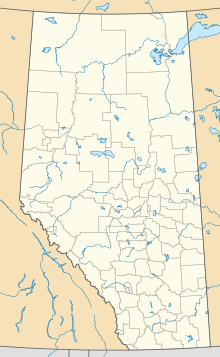Gainford, Alberta
Gainford | |
|---|---|
Hamlet | |
 Location of Gainford in Alberta | |
| Coordinates: 53°35′13″N 114°47′17″W / 53.5869°N 114.7881°WCoordinates: 53°35′13″N 114°47′17″W / 53.5869°N 114.7881°W | |
| Country | Canada |
| Province | Alberta |
| Census division | No. 11 |
| Municipal district | Parkland County |
| Founded by | Grand Trunk Pacific Railway |
| Named for | Gainford, County Durham, England |
| Government | |
| • Type | Unincorporated |
| • Mayor | Allan Gamble |
| • Governing body | Parkland County Council
|
| Area (2021)[1] | |
| • Land | 1.36 km2 (0.53 sq mi) |
| Elevation | 740 m (2,430 ft) |
| Population (2021)[1] | |
| • Total | 118 |
| • Density | 86.7/km2 (225/sq mi) |
| Time zone | UTC−7 (MST) |
| • Summer (DST) | UTC−6 (MDT) |
Gainford is a hamlet in Alberta, Canada within Parkland County.[2] It is located approximately 86 kilometres (53 mi) west of Edmonton and has an elevation of 740 metres (2,430 ft).
The hamlet is located in Census Division No. 11 and in the federal riding of Yellowhead. The north border of Gainford shares part of the shore of Isle Lake. The Yellowhead Highway (Alberta Highway 16) passes through Gainford.
History[]
The first post office opened in 1910. The community takes its name from Gainford, County Durham, England.[3][4]
Demographics[]
In the 2021 Census of Population conducted by Statistics Canada, Gainford recorded a population of 118 living in 49 of its 67 total private dwellings, a change of 19.2% from its 2016 population of 99. With a land area of 1.36 km2 (0.53 sq mi), it had a population density of 86.8/km2 (224.7/sq mi) in 2021.[1]
As a designated place in the 2016 Census of Population conducted by Statistics Canada, Gainford recorded a population of 79 living in 38 of its 53 total private dwellings, a change of -40.2% from its 2011 population of 132. With a land area of 1.08 km2 (0.42 sq mi), it had a population density of 73.1/km2 (189.5/sq mi) in 2016.[5]
See also[]
References[]
- ^ a b c "Population and dwelling counts: Canada and designated places". Statistics Canada. February 9, 2022. Retrieved February 10, 2022.
- ^ "Specialized and Rural Municipalities and Their Communities" (PDF). Alberta Municipal Affairs. January 12, 2022. Retrieved January 21, 2022.
- ^ Place-names of Alberta. Ottawa: Geographic Board of Canada. 1928. p. 55.
- ^ Harrison, Tracey (1994). Place Names of Alberta. Volume III: Central Alberta. Calgary, AB: University of Calgary Press. p. 98. ISBN 1-895176-44-1.
- ^ "Population and dwelling counts, for Canada, provinces and territories, and designated places, 2016 and 2011 censuses – 100% data (Alberta)". Statistics Canada. February 8, 2017. Retrieved February 13, 2017.
- Hamlets in Alberta
- Designated places in Alberta
- Parkland County
- Edmonton Capital Region geography stubs
